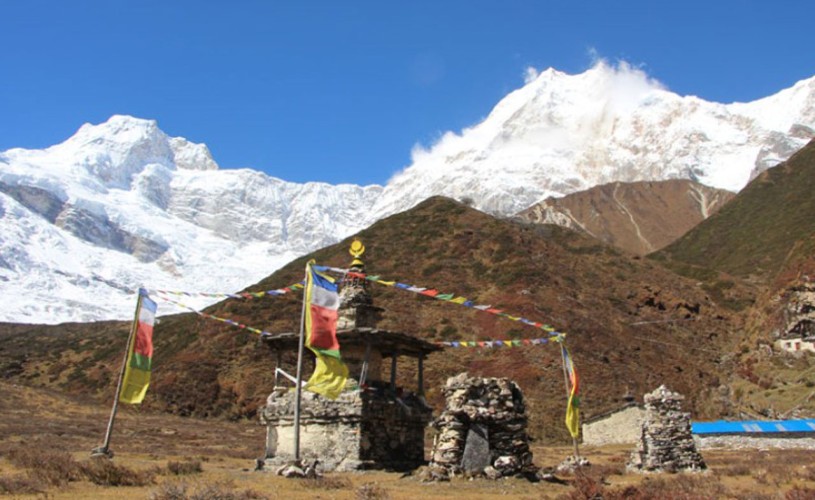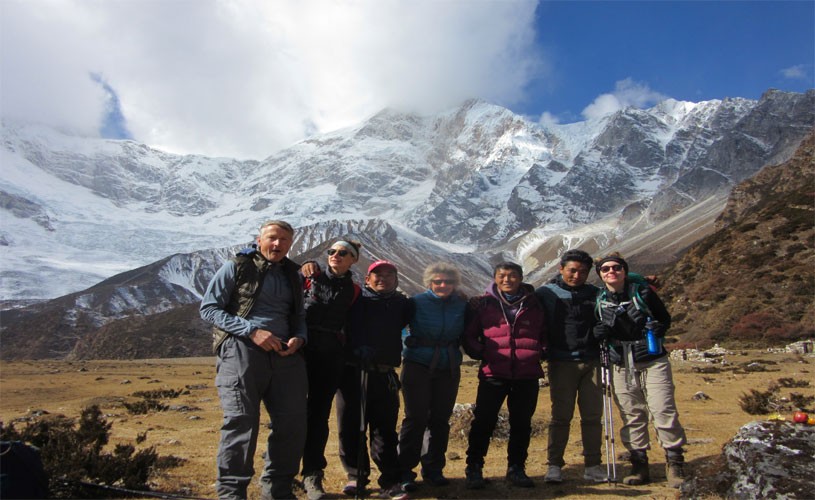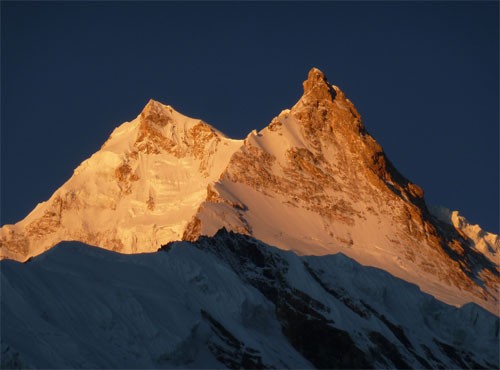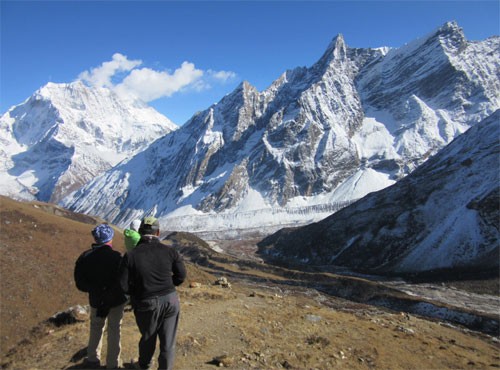Key Highlights of Manaslu Circuit Trek:
- Stunning views of Mount Manaslu, the eighth-highest peak in the world
- Challenging Larkya La Pass at an altitude of 5135 meters
- Unique culture and lifestyle of Tamangs and Gurungs
- Remote Tibetan-style villages like Samdo and Lho
- Ancient monasteries and gompas
- Rhododendron forests, waterfalls, and natural hot springs
- Opportunity to experience the rich cultural traditions and customs of the locals
- Panoramic views of the Annapurna range and other surrounding mountains
- Physical challenge and opportunity for adventure and personal growth.
Manaslu Circuit Trek: Itinerary, Cost & Complete Guide for 2026
The Manaslu Circuit Trek is one of the most demanding and best adventure treks in Nepal, taking you through the heart of the Manaslu Conservation Area and around Mount Manaslu (8,163 m)—the world’s eighth-highest peak.
Unlike the crowdedEverest Base Camp or Annapurna Circuit routes, this hidden Himalayan trek remains peaceful and less developed, offering a closer connection to both nature and living Himalayan culture.
Along this route, you will explore high alpine scenery, Tibetan Buddhist villages, deep gorges, deep valleys, rolling rivers, rice terraces, and quiet mountain lives—making it a top remote trek in Nepal for travelers who crave scenery and culture.
The journey begins with a 7–8-hour drive from Kathmandu to Machha Khola, passing through the Trishuli River valley, Gorkha Bazaar, Arughat, terraced hillsides, and small Gurung settlements.
After an overnight stay, the Manaslu trek officially begins, following the Budi Gandaki trekking route. The trail rises steadily through remote villages like Jagat, Deng, and Lho, crossing swaying suspension bridges and winding past subtropical forests and waterfalls.
As you approach Samagaon, dramatic views of Mount Manaslu, Naike Peak, and Manaslu North begin to fill the skyline. A side hike to Manaslu Base Camp provides up-close views of glaciers and ice-covered cliffs—one of the trek’s top highlights.
The Tsum Valley side trip can be added if you have a few extra days. This hidden valley is home to Tibetan-style villages,centuries-old monasteries like Mu Gompa, and sacred sites rarely visited on Nepal’s mainstream treks. Throughout the route, you’ll pass prayer flags, mani walls, and chortens—signs that Tibetan Buddhist traditions still thrive in this high-altitude region.
After proper acclimatization in Samagaon and a visit to Birendra Lake or Pungyen Gompa during the rest day, the trail climbs higher to Samdo and Dharamsala, revealing sweeping views of Himlung Himal, Cheo Himal, Annapurna II, and Ganesh Himal.
The final ascent to Larke Pass (5,106 m) is steep and icy but deeply fulfilling, offering 360-degree panoramas of untouched Himalayan wilderness. This section is considered one of the most scenic in the Larke Pass trek, where trekkers often use microspikes or crampons depending on snow and season.
As you approach Samagaon, the views of Mount Manaslu, Naike Peak, and Manaslu North begin to dominate the skyline. A side hike to Manaslu Base Camp offers a close-up view of glaciers and towering peaks that make this trek unforgettable.
Trekkers are required to obtain special trekking permits because the Manaslu region is a restricted area. You’ll need a Manaslu Restricted Area Permit (RAP), as well as MCAP and ACAP entry permits. As solo trekking is not allowed here, you’ll need at least two trekkers and a government-licensed guide, as required by Nepal’s regulations.
The best months to trek are from March to May and September to November, when the skies are clear, the weather is stable, and the mountain views are at their best.
Ready to experience the unforgettable journey? Join us for the Manaslu Circuit Trek and explore the amazing Tibetan culture and breathtaking Himalayan views. We’ll handle the permits and planning so you can focus on the adventure.
The Manaslu Circuit is not just a trek—it’s a journey through raw Himalayan wilderness, deep cultural roots, and ancient mountain villages untouched by mass tourism. If you're looking for a true teahouse trek in Nepal that blends physical challenge with authentic local experience, the Manaslu Circuit remains one of the most rewarding trails in the Himalayas.
Why Choose the Manaslu Circuit Trek?
The Manaslu Circuit Trek is one of Nepal’s most remote, off-the-beaten-path treks, offering a truly authentic Himalayan experience. Trekkers are treated to stunning mountain views, lush forests, diverse flora and fauna, and spectacular waterfalls, all while immersing in the local culture and traditions.
Unlike the more popular Everest Base Camp (EBC) or Annapurna Base Camp (ABC) treks, Manaslu lies in a restricted area, requiring special permits and a trekking partner with a licensed guide or porter. The trail sees far fewer crowds, making it ideal for those seeking solitude and a genuine trekking experience.
While EBC and ABC treks are considered moderate, the Manaslu trek is graded as strenuous due to its longer distances and challenging terrain. Despite this, the success rate for completing Manaslu is high, thanks to careful planning, proper acclimatization, and the support of experienced guides.
How difficult is the Manaslu Circuit Trek?
The Manaslu Circuit Trek is approximately 177 km long (110 mi). It takes 13 days on average to complete. You'll hike for 10-11 consecutive days and average a daily distance between 13 and 16 km (7-10 mi). The steep Budi Gandaki Gorge and the uphill and downward sections of the trail can make the initial stages of the trek challenging. Larkya La Pass is at 5,106 m (16,752 ft), the highest point on the trek. This section is the most difficult and involves hiking on long, snow-covered trails. Altitude sickness is a major challenge you might face during the Manaslu Circuit Trek due to the significant changes in altitude. If you do the trek in a season other than winter, then no mountaineering skills or technical knowledge are required. Even for novice trekkers, it is essential to maintain a good level of physical fitness. To maintain fitness, it is recommended that you engage in strength and endurance training as well as cardio-fitness exercises at least three months before starting your trek.
How Much Does the Manaslu Circuit Trek Cost?
The cost of the Manaslu Circuit Trek in 2025 or 2026 will depend on the group size. On average, the trek costs between USD 1,150 and USD 1,300 per person. The price may vary based on the number of people, the type of service you choose, and the level of itinerary customization.
At Adventure Club Trek, we offer flexible pricing tailored to your group. Whether you're traveling solo or with friends, we’ll provide a cost-effective package that covers everything you need—permits, accommodations, transportation, meals, and a licensed local guide.
| No. of Pax | Starting Price | |
| 1 pax | USD 1333 per person | |
| 2 to 6 pax | USD 1289 per person | |
| 7 to 10 pax | USD 1199 per person | |
| 11 to 14 pax | USD 1150 per person |
Have a group of more than 10 trekkers?
Contact us directly for special group discounts and customized rates for larger teams.
Do I need a special permit for the Manaslu Circuit Trek?
Yes, trekkers are required to obtain special permits to explore the Manaslu Circuit, as it passes through a restricted region between Jagat and Dharapani in north-central Nepal. Solo trekking is not allowed in this area, and every group must include at least two people accompanied by a licensed guide from a registered Nepali trekking agency. Independent guides or freelance trekking leaders are not permitted.
To complete the trek legally, you'll need three permits, and if you're planning to include the Tsum Valley extension, an additional permit is required. Here's a breakdown of the required permits and their costs:
Special Restricted Area Permit for Manaslu (Manaslu RAP)
The Cost of the Trekking permits
From September to November: USD 100 per person for the first seven nights and USD 15 extra per person each day after the eighth night.
From December to August: USD 75 per person for the initial seven days, and USD 10 extra per person each day after the eighth.
Manaslu Conservation Area Project (MCAP Permit)

This permit is required from Philm, where the Manaslu Conservation Area starts. The price is USD 30 year-round for any days you spend inside the conservation area.
Annapurna Conservation Area Project (ACAP Permit)
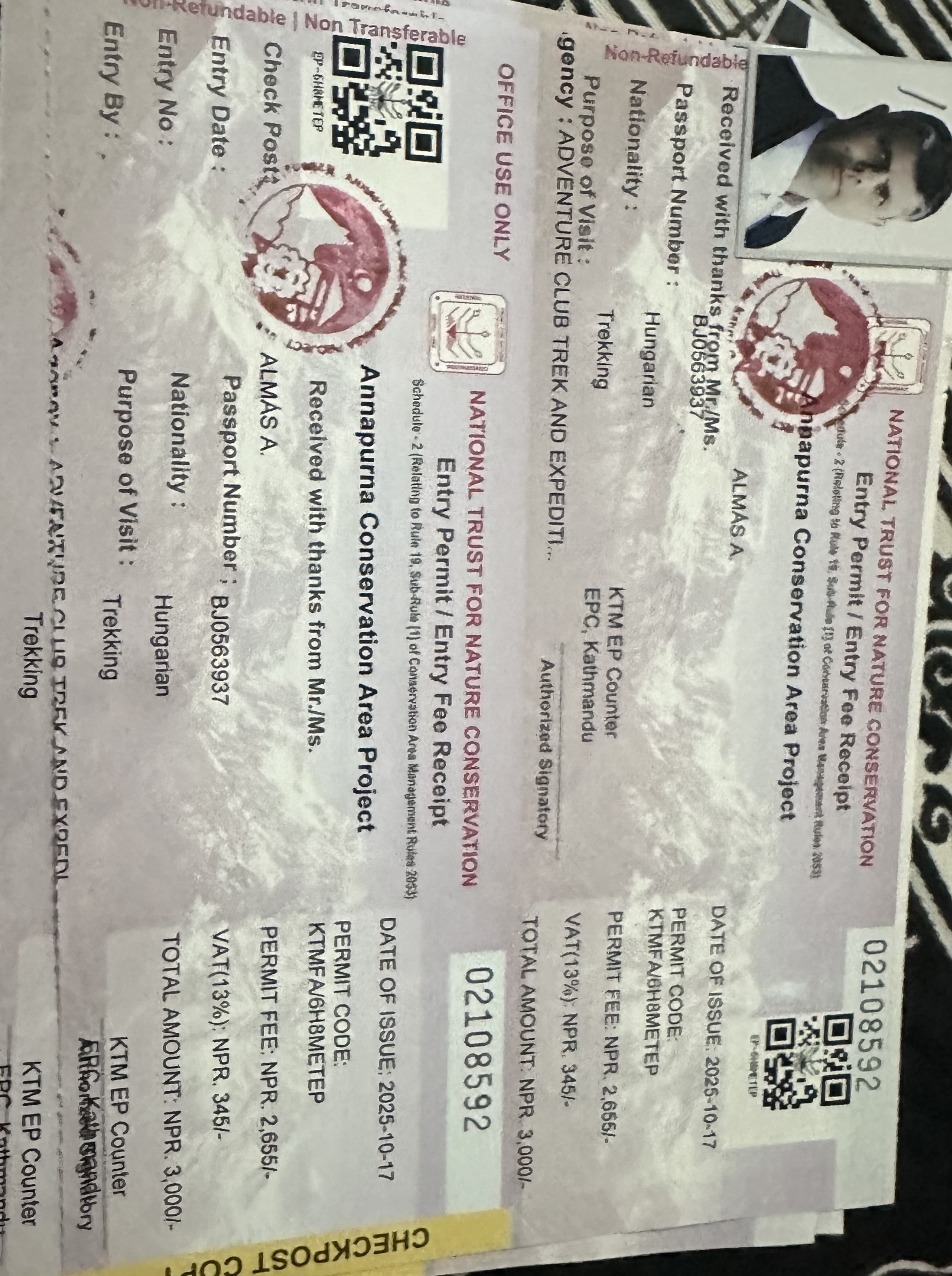
You will need this permit from Dharapani to exit ACAP at Beshi Sahar. The cost of any day spent in the ACAP conservation zone is USD 30.
If your itinerary includes the Tsum Valley, which branches off from Lokpa, an extra restricted area permit is necessary.
September to November: USD 40 per person for the first 7 days; December to August: USD 30 for the same duration
Important Guidelines for Manaslu Trek Permits
Solo trekking is not allowed in the restricted area; you must be part of a group with a government-registered guide. Permits can only be arranged through a registered trekking agency in Nepal—you cannot apply as an individual.
The original passport and valid Nepal visa are required to issue the permits, and the permits are non-transferable and non-refundable once issued.

What is the best time to do the Manaslu Circuit Trek?
The ideal time to go on the Manaslu Circuit Trek is during the autumn (September to November) and spring (March to May) seasons. These periods offer the best weather and optimal conditions for a successful and enjoyable trekking experience. During autumn, the weather is generally stable with clear skies, providing magnificent views of the surrounding peaks, including Manaslu, which stands at 8,156 meters (26,759 feet). The moderate temperatures make it comfortable for trekking, and the trail is typically dry and easily passable. The landscape comes alive in spring with colorful rhododendron blooms and lush vegetation. The weather remains pleasant, and the clear skies allow for stunning vistas. The temperatures gradually rise, melting the winter snow and ensuring safer passage across high-altitude sections of the trail.
Is it possible to do the Manaslu Circuit Trek solo?
No, solo trekking is not allowed on the Manaslu Circuit due to government restrictions. As the trail passes through a restricted area, trekkers must be in a group of at least two and accompanied by a licensed guide from a registered Nepali agency. This rule ensures safety, supports local employment, and preserves the region's cultural integrity. An individual traveler can still join group departures arranged by registered trekking agencies to experience this breathtaking remote Himalayan adventure legally.



